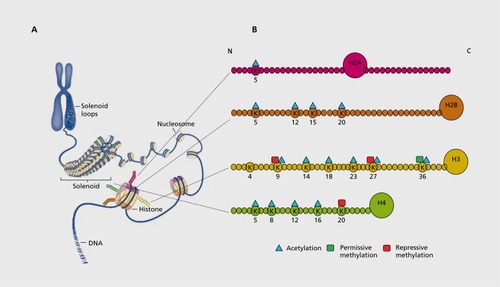Figures & data
![Figure 1. Epigenetic dysregulation in the HPA axis and reward circuitry is implicated in psychiatric disorders. A majority of research on altered epigenetic regulation in depression and other stress-related disorders has focused on changes within the HPA axis (A) and the brain's reward circuitry (B), depicted here in the rodent brain. Studies examining the effects of early-life manipulations on epigenetic regulation of behavior have focused on changes within the HPA axis, in contrast to adult studies, which have concentrated on epigenetic alterations in the reward circuitry. A) Main components of the HPA axis: CRF and AVP from the paraventricular nucleus of the PVN stimulates ACTH release from the anterior pituitary, which induces glucocorticoid (cortisol [human] or corticosterone [rodent]) release from the adrenal cortex. GRs in the HPC and other brain regions mediate negative feedback to reduce the stress response. B) Depicted are the major components of the limbic-reward circuitry: dopaminergic neurons (green) project from the VTA to the NAc, PFC, AMY, and HPC, among other regions. The NAc receives excitatory glutamatergic innervation (red) from the HPC, PFC, and AMY. ACTH, adrenocorticotropic hormone; AMY, amygdala; AVP, vasopressin; CRF, corticotropin releasing factor; GRs, glucocorticoid receptors; HPA, hypothalamic-pituitary-adrenal axis; HPC, hippocampus; PFC, prefrontal cortex; PVN, hypothalamus; VTA, ventral tegmental area.](/cms/asset/10d095a5-5d18-4620-b541-8b9c0c36d8b9/tdcn_a_12130967_f0001_oc.jpg)

Register now or learn more
Open access
![Figure 1. Epigenetic dysregulation in the HPA axis and reward circuitry is implicated in psychiatric disorders. A majority of research on altered epigenetic regulation in depression and other stress-related disorders has focused on changes within the HPA axis (A) and the brain's reward circuitry (B), depicted here in the rodent brain. Studies examining the effects of early-life manipulations on epigenetic regulation of behavior have focused on changes within the HPA axis, in contrast to adult studies, which have concentrated on epigenetic alterations in the reward circuitry. A) Main components of the HPA axis: CRF and AVP from the paraventricular nucleus of the PVN stimulates ACTH release from the anterior pituitary, which induces glucocorticoid (cortisol [human] or corticosterone [rodent]) release from the adrenal cortex. GRs in the HPC and other brain regions mediate negative feedback to reduce the stress response. B) Depicted are the major components of the limbic-reward circuitry: dopaminergic neurons (green) project from the VTA to the NAc, PFC, AMY, and HPC, among other regions. The NAc receives excitatory glutamatergic innervation (red) from the HPC, PFC, and AMY. ACTH, adrenocorticotropic hormone; AMY, amygdala; AVP, vasopressin; CRF, corticotropin releasing factor; GRs, glucocorticoid receptors; HPA, hypothalamic-pituitary-adrenal axis; HPC, hippocampus; PFC, prefrontal cortex; PVN, hypothalamus; VTA, ventral tegmental area.](/cms/asset/10d095a5-5d18-4620-b541-8b9c0c36d8b9/tdcn_a_12130967_f0001_oc.jpg)

People also read lists articles that other readers of this article have read.
Recommended articles lists articles that we recommend and is powered by our AI driven recommendation engine.
Cited by lists all citing articles based on Crossref citations.
Articles with the Crossref icon will open in a new tab.